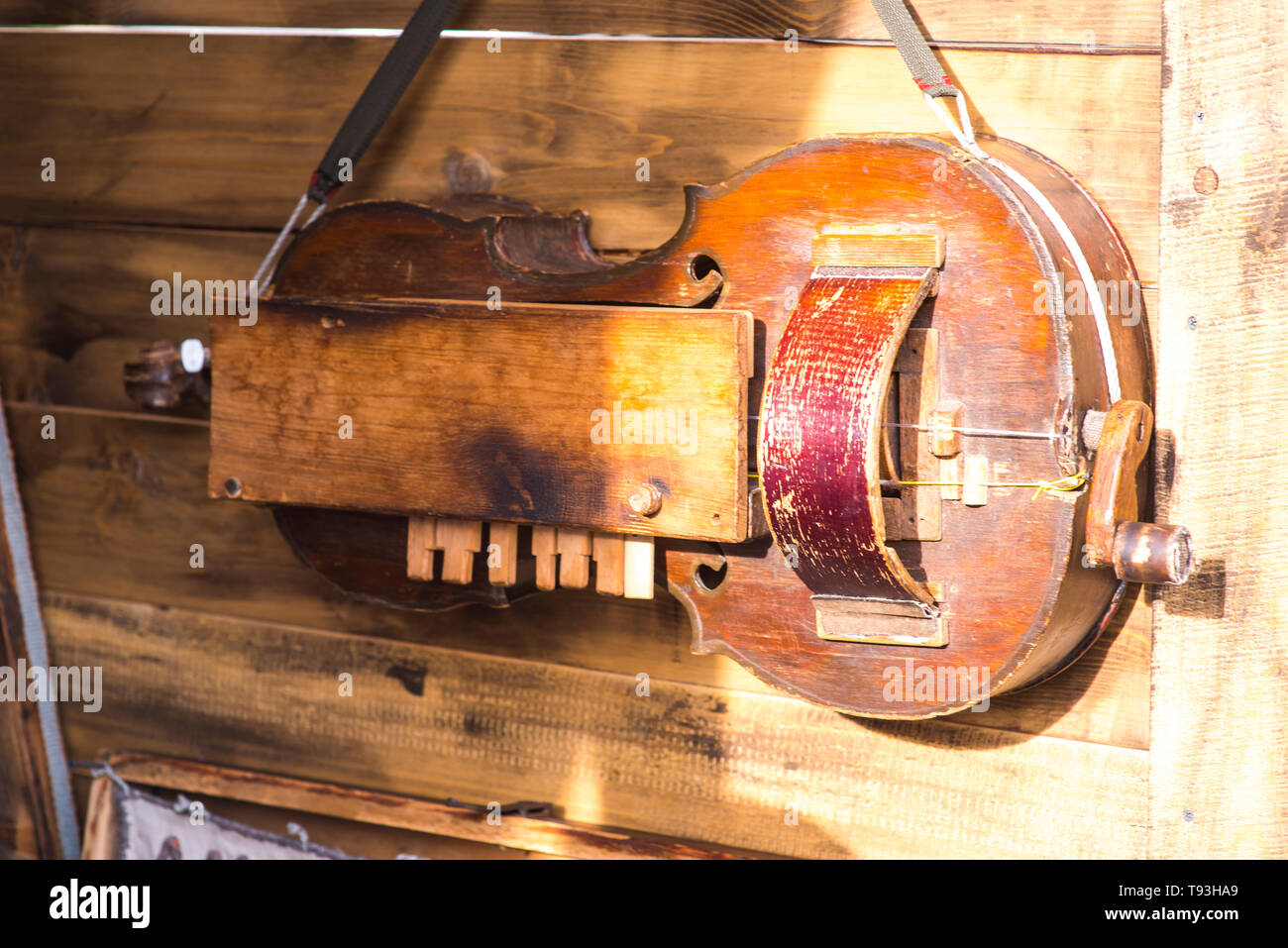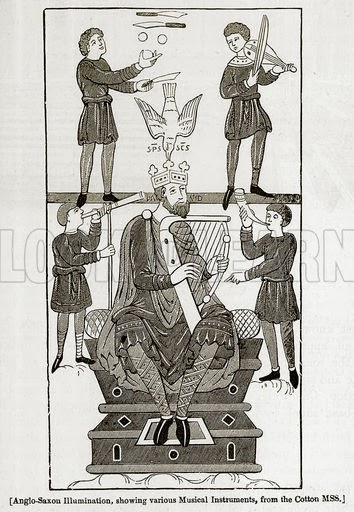Anglo Saxon Musical Instruments
Music of the Viking Age

Stories and Songs Oral tradition of storytelling A way to record history Scop: bard, minstrel Stringed Instruments 'Hearpere' and 'to harp on' Caedmon as musician Lyre Harp Rebec Cithara Monocord Organistrum Psalteries Dulcimers Fig. 1: King David composing the Psalms. By Richard Denning. We have a pretty good idea of what musical instruments the Anglo-Saxons used. The Cotton collection in the British Museum includes the top image showing a Saxon king playing a harp with a horn player, an early trumpet and a rebec (a early violin type instrument). The lower image shows a lyre, bone flute and another type of woodwind.

If people in the Viking lands created and enjoyedmusic, they left little behind to prove it. Other European lands in the Viking age left behind extensive evidence of music. We find the instruments themselves, descriptions of instruments, stories about instruments, and pictures of instruments, such as the harp shown to the left in an Anglo-Saxon manuscript from around the year 1000. |
However, in the Viking lands, the literary and archaeologicalrecords supporting the presence of music are very slight. In the later part of the era, after theconversion to Christianity, the records are more clear, and it is likely thatmusic was as much a part of Christian life in Norse lands as anywhere else inEurope. However, for the early part of the era, littleevidence exists that tells us about the type of music performed or about theinstruments on which it was performed.
Anglo Saxon History And Culture
One might expect that at least a few Viking era musical instruments would survive. One one hand, the organic materials from which instruments were made are unlikely to remainintact after centuries of burial. On the other hand, unusual conditions have permitted a large number ofother organic artifacts to have survived. Regardless, few musical instruments or parts ofinstruments have been found from the Viking age in Viking lands.
Amongthe most convincing musical instrument find isthe 10th century bone flute found at Birka (left), which remainsplayable today. Other notable artifacts include a portion of a 10thcentury set of wooden pan pipes found at York (right), and the 9th centuryamber bridge from an unknown six stringed instrument found in a burial at Broa. |
This is in stark contrast to the hundreds of other bone artifacts (such as combs and needles), and the thousands of wood artifacts that have been found. The scarcity suggests that musical instruments simply were not very common in Viking lands.
The literary record is even more confusing. Fromstories that take place later in the Norse era, we learn that men ofaccomplishment prided themselves on their musical abilities. For example, EarlRögnvaldr Kali Kolsson claimed to have mastered music and verse in chapter 58of Orkneyinga saga. Morkinskinna records a verse by KingHaraldr harðráði in which he claims to have mastered harp-playing and poetry.

Musicalinstruments are rarely mentioned in the Norse literature.Perhaps one of the most familiar examples is the story of Gunnar, described inboth Atlakviða (verse 31) and Atlamál (verse 66). Atli threwGunnar into a snake pit. To calm the snakes, Gunnar played his harp, but to noavail. In Atlamál, it is said that Gunnar played the harp with his toes,presumably because his hands were bound. This scene is depicted on the stavechurch portal from Hylestad, carved at the beginning of the 13thcentury (right). |
Another harp is mentioned in Voluspá (verse42), played by a giantess’s herdsman. In chapter 4 of Viglundar saga,it is said that Earl Eiríkur entertained King Haraldur with various music, bothsongs and stringed instruments. In chapter 7 of Bárðar saga Snæfellsáss,Helga played the harp all night in her bed. In chapter 3 of Jökuls þátturBúasonar, Jökull was entertained with songs and bassoon music whilevisiting King Soldan in the land of the Saracens. Horns (lúðr) were blown to call men to battle, such as in chapter 9 of Vatnsdæla saga.
In the Sagas of Icelanders, Christian mass is sung (Brennu-Njálssaga chapter 124 and others), weapons sing (a sword, an axe, and a halberd in chapters 30, 44, 54, and 79 of Brennu-Njáls saga), but rarely do peoplesing. Two familiar examples are frequently cited.
In chapter 4 of Eiríks saga rauða, Guðríðrwas urged to help a sorceress. Even though she knew the varðlokkur (wardchants), she was reluctant to participate, because she was a Christian.Ultimately, she spoke the chant beautifully. In chapter 37 of Laxdæla saga,the sorceress Grima practiced her magic, speaking chants that were sweet to theear. In both cases, magic rites (seiður) were being performed, and thechants were an integral part of the rites.
Perhaps the most convincing example of singing comesfrom chapter 87 and 88 of Grettis saga. While imprisoned in Byzantium,Þorsteinn sang songs to keep his spirits high. His fine voice attracted theattention of Spes, who arranged his release.
After the conversion to Christianity near the end ofthe Viking era, music would more certainly have been a part of daily life. Musicin the church in Norse lands would have been the same as anywhere else in Europeat the time: psalms and hymns were sung as part of daily worship.
One expects that if singing and music were animportant part of daily life in the Norse era, more evidence of it would havesurvived, both in the literature and in the archaeological records. However,the lack of evidence proves little. The best we can say is that we simply donot know whether music was performed or not. We do not know the nature of theperformances nor the nature of the instruments on which it was performed.
Anglo Saxon Song
Despite the sparse evidence, talented instrument makers and musicians have created replica Viking-age instruments and used them in performances with very interesting and entertaining results. On the left is a photo of replicas of stringed instruments, and on the right, various wind instruments created by Jón Sigurðsson. |
Anglo-saxon Musical Instruments
©2001-2020 William R. Short |